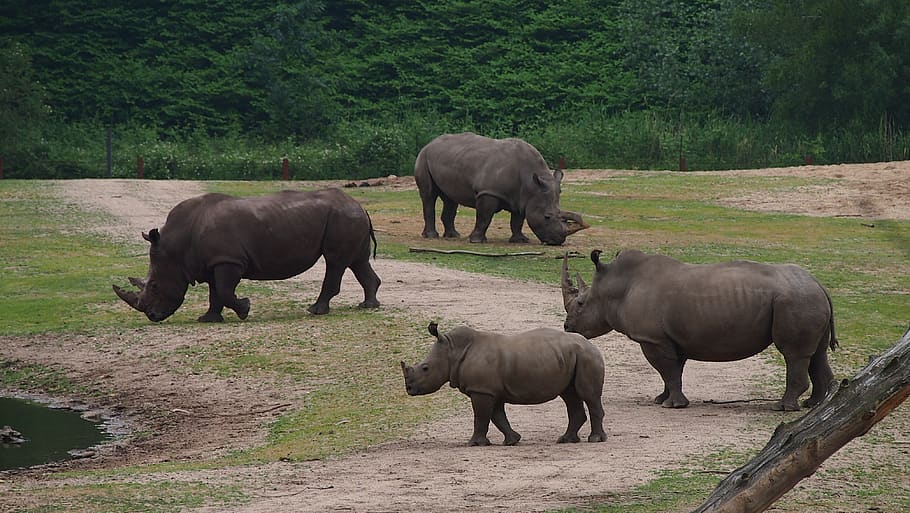On eve of World Rhino Day, Varun Goswami says engagement with governments of more countries needed to prevent illegal trade of rhino horn
NEW DELHI (AA) – Climate change is a “very real and serious threat” to rhinos and India is on a right track in terms of rhino population recovery, a leading Indian ecologist and conservation scientist has said.
On the eve of World Rhino Day, observed on Wednesday, Varun R. Goswami, the founder of Conservation Initiatives, a wildlife conservation organization based in northeastern India, told Anadolu Agency that India must continue to accord high levels of protection of the most highly protected species under the Indian Wildlife act.
The greater one-horned rhino population was once spread across Asia but due to hunting and habitat loss, by the early 1900s, the numbers came down. Over the years, strict policies have increased the population of the rhinos, currently over 3,500.
According to Goswami, who has worked on rhinos, they like swampy grassland habitat, largely found on floodplains of rivers like the Indian Brahmaputra.
“While rhinos are well adapted to such floodplain ecosystems, extreme weather events, such as floods and droughts, are expected to increase in frequency and magnitude due to climate change,” said Goswami. “In such a context, and given that most rhinos are found in a handful of protected areas that can be impacted by such weather extremes, climate change is a very real and serious threat to rhinos, moving forward.”
The recovery of the greater one-horned rhinoceros, also known as the Indian rhinoceros, is a “well-known and celebrated conservation success story,” he added.
“From a scenario where the species — historically known to range across the northern part of the Indian subcontinent along the basins of the Indus, Ganga, and Brahmaputra Rivers — was reduced to only a handful in the early 1900s, up to an estimated number of 3,500 today is indeed a phenomenal conservation achievement.
“Kaziranga National Park in Assam in northeastern India lies at the heart of this success story, supporting over 70% of this estimated rhino population across its current range, comprising eight protected areas in India and four in Nepal,” he also said.
He added that the country “must not rest on our laurels as rhinos in the wild continue to face major threats of poaching, and India must continue to accord high levels of protection.”
India is on the right track in terms of rhino population recovery, Goswami said, noting that the focus needs to be on sustaining healthy populations in habitats where they occur in high density and helping new populations — like the reintroduced population in the Manas National Park — grow as well as on increasing the number of rhino habitats by reintroducing them to other suitable protected areas.
“These three complementary areas of focus will help the overall rhino population to grow and remain healthy, while also distributing rhinos across multiple habitats (protected areas) such that we are not in a position of ‘all eggs in one basket’ in the face of threats such as poaching and climate change,” he said.
Goswami also noted that the government needs to take more steps in view of flooding of the Kaziranga National Park in the Assam state, which is home to over 70% of the estimated rhino population.
The Kaziranga National Park almost every year witnesses floods, with experts saying it has now become necessary by virtue of its ecosystem.
“The government should therefore take up strategies, including the installation of mitigation measures along the national highway and/or better regulating vehicular speeds and volume, so as to enable wildlife to cross the highway more easily,” he said. “In addition, wildlife habitat in Karbi Anglong needs to be better secured in partnership with local communities in the area.”
According to Goswami, there is a need for engagement with governments of some countries “such as China and Vietnam that serve as major destinations for the illegal trade in rhino horn.”
The five rhino range nations — India, Bhutan, Nepal, Indonesia, and Malaysia — have signed a declaration, The New Delhi Declaration on Asian Rhinos 2019, for the conservation and protection of the species.
“As long as demand for rhino horn keeps emanating from such countries, protecting rhinos in their habitats will remain a massive challenge, as evidenced by the situation in Africa,” he also noted.
Rhino population rising
According to Goswami, the dual goal of the Indian Rhino Vision 2020 was timely and important, to contribute to population recovery of rhinos in Assam, and to reintroduce rhinos in erstwhile habitats through wild-to-wild translocations from healthy high-density populations, such as the one in the Kaziranga National Park.
In 2005, the Indian government launched the Indian Rhino Vision 2020 that aimed to attain a wild population of at least 3,000.
“Given uncertainties associated with estimating animal populations, it is difficult to pinpoint an exact number of rhinos today, but the fact that rhino populations in protected areas like the Kaziranga National Park and Pobitora Wildlife Sanctuary have grown considerably over the years is undeniable,” he said.

